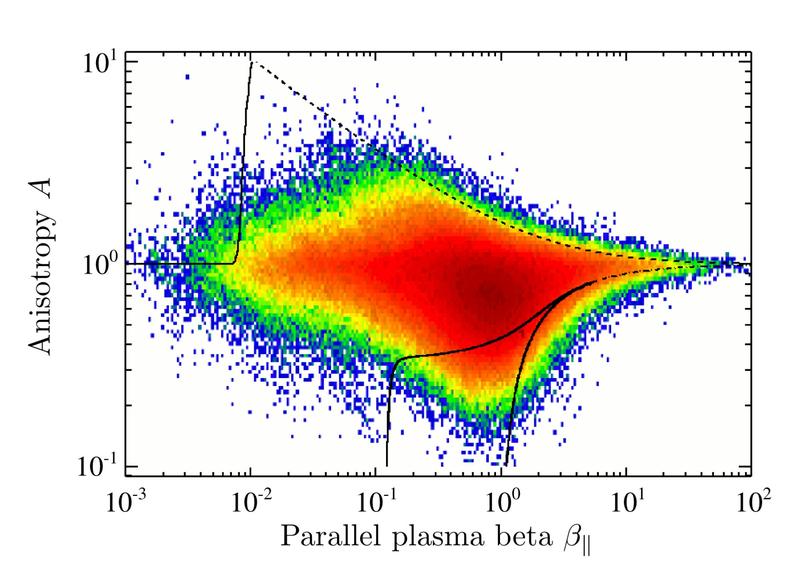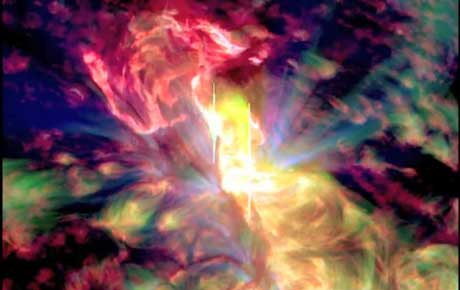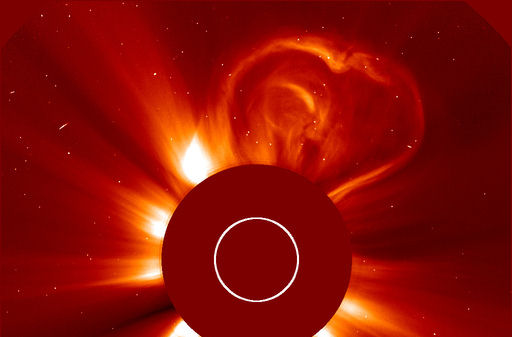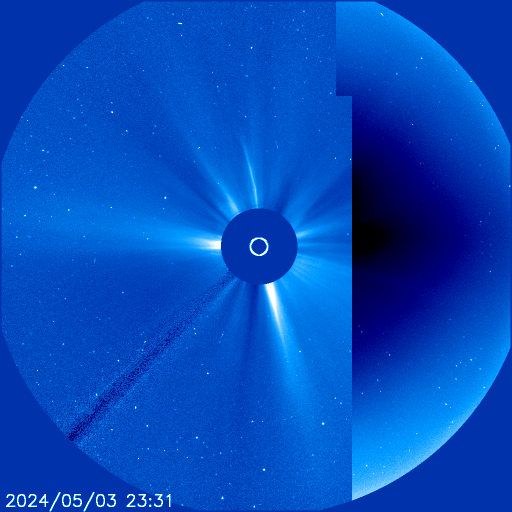Il Sole Rilascia 6 Spettacolari Espulsioni
Inviato: 20/09/2011, 21:56
Riporto in un 3ad separato la notizia...
Le espulsioni di massa coronale sono tra i fenomeni più potenti ed energetici che si possono trovare nel Sistema Solare. Si tratta di enormi quantità di plasma (fatto principalmente da elettroni e protoni, ma anche di piccole quantità di elio, ossigeno e ferro) che vengono trascinate dal campo magnetico della corona e rilasciate nello spazio. Spesso si associano le Espulsioni di massa coronale (CME) con altri tipi di attività solare, come i brillamenti solari, ma non si sa di alcuna relazione causale tra questi due fenomeni. La maggior parte delle CME hanno origine nelle regioni più attive della superficie del Sole, come gruppi di macchie solari. Vicino al periodo di massima solare, il Sole può rilasciarne anche 3 al giorno in media, mentre nel periodo di minima solare ne può rilasciare anche 1 ogni 5 giorni. Il fatto che ha stupito gli astronomi è che tra il 18 ed il 19 Settembre, il Sole ne ha rilasciati 6 in sole 24 ore!
Per decine di anni, il meccanismo dietro questo estremi fenomeni solari sono stati un mistero, ma adesso, grazie ai grandi progressi nello studio del Sole, specialmente per via di osservatori spaziali potentissimi come SOHO, STEREO e SDO, è stato possibile capire la loro origine. Si tratta di un fenomeno chiamato riconnessione magnetica, in cui si ha un ri-arrangiamento delle linee del campo magnetico quando due campi magnetici opposti sono portati molto vicino l'uno all'altro. Questo ri-arrangiamento è accompagnato da un improvviso rilascio dell'energia depositata tra i due campi magnetici opposti.
Sul Sole, la riconnessione magnetica potrebbe avvenire sulle arcate solari, cioè su una serie di piccole e ravvicinate linee magnetiche. Queste linee di forze si riconnettono velocemente in una serie di anelli ad arcata bassa, lasciando una spirale del campo magnetico non connesso con il resto dell'arcata. Questo improvviso rilascio di energia in questa riconnessione può causare un brillamento solare. Il campo magnetico non connesso, della spirale, insieme al materiale che contiene, possono espandersi molto violentemente verso l'esterno, rilasciando un'Espulsione di Massa Coronale.
Questo spiega anche perché le CME ed i brillamenti solari, tipicamente hanno luogo da quelle che vengono chiamate regioni attive sul Sole, dove i campi magnetici sono molto più potenti in media.
Secondo i primi modelli sviluppato dalla NASA, una di queste Espulsioni di Massa coronali, dovrebbe colpire la Terra alle 17 ET, il 21 Settembre, generando un bel po' di splendide aurore.
http://www.nasa.gov/mission_pages/sunea ... 6cmes.html
http://en.wikipedia.org/wiki/Coronal_mass_ejection
Fonte: http://www.link2universe.net/2011-09-20 ... le-24-ore/
In aggiunta un altro interessante articolo....
The Secret Lives of Solar Flares
Sept. 19, 2011: One hundred and fifty two years ago, a man in England named Richard Carrington discovered solar flares.
It happened at 11:18 AM on the cloudless morning of Thursday, September 1st, 1859. Just as usual on every sunny day, the 33-year-old solar astronomer was busy in his private observatory, projecting an image of the sun onto a screen and sketching what he saw. On that particular morning, he traced the outlines of an enormous group of sunspots. Suddenly, before his eyes, two brilliant beads of white light appeared over the sunspots; they were so bright he could barely stand to look at the screen.
Carrington cried out, but by the time a witness arrived minutes later, the first solar flare anyone had ever seen was fading away.
It would not be the last. Since then, astronomers have recorded thousands of strong flares using instruments ranging from the simplest telescopes in backyard observatories to the most complex spectrometers on advanced spacecraft. Possibly no other phenomenon in astronomy has been studied as much.
After all that scrutiny, you might suppose that everything about solar flares would be known. Far from it. Researchers recently announced that solar flares have been keeping a secret.
“We’ve just learned that some flares are many times stronger than previously thought,” says University of Colorado physicist Tom Woods who led the research team. “Solar flares were already the biggest explosions in the solar system—and this discovery makes them even bigger.”
NASA’s Solar Dynamics Observatory (SDO), launched in February 2010, made the finding: About 1 in 7 flares experience an “aftershock.” About ninety minutes after the flare dies down, it springs to life again, producing an extra surge of extreme ultraviolet radiation.
“We call it the ‘late phase flare,’” says Woods. “The energy in the late phase can exceed the energy of the primary flare by as much as a factor of four.”
What causes the late phase? Solar flares happen when the magnetic fields of sunspots erupt—a process called “magnetic reconnection.” The late phase is thought to result when some of the sunspot’s magnetic loops re-form. A diagram prepared by team member Rachel Hock of the University of Colorado shows how it works.

The extra energy from the late phase can have a big effect on Earth. Extreme ultraviolet wavelengths are particularly good at heating and ionizing Earth’s upper atmosphere. When our planet’s atmosphere is heated by extreme UV radiation, it puffs up, accelerating the decay of low-orbiting satellites. Furthermore, the ionizing action of extreme UV can bend radio signals and disrupt the normal operation of GPS.
SDO was able to make the discovery because of its unique ability to monitor the sun’s extreme UV output in high resolution nearly 24 hours a day, 7 days a week. With that kind of scrutiny, it’s tough to keep a secret--even one as old as this.
The original research (http://iopscience.iop.org/0004-637X/739/2/59) of Woods et al may be found in the Oct. 1, 2011, issue of the Astrophysical Journal.
Fonte: http://science.nasa.gov/science-news/sc ... cretlives/
Le espulsioni di massa coronale sono tra i fenomeni più potenti ed energetici che si possono trovare nel Sistema Solare. Si tratta di enormi quantità di plasma (fatto principalmente da elettroni e protoni, ma anche di piccole quantità di elio, ossigeno e ferro) che vengono trascinate dal campo magnetico della corona e rilasciate nello spazio. Spesso si associano le Espulsioni di massa coronale (CME) con altri tipi di attività solare, come i brillamenti solari, ma non si sa di alcuna relazione causale tra questi due fenomeni. La maggior parte delle CME hanno origine nelle regioni più attive della superficie del Sole, come gruppi di macchie solari. Vicino al periodo di massima solare, il Sole può rilasciarne anche 3 al giorno in media, mentre nel periodo di minima solare ne può rilasciare anche 1 ogni 5 giorni. Il fatto che ha stupito gli astronomi è che tra il 18 ed il 19 Settembre, il Sole ne ha rilasciati 6 in sole 24 ore!
Per decine di anni, il meccanismo dietro questo estremi fenomeni solari sono stati un mistero, ma adesso, grazie ai grandi progressi nello studio del Sole, specialmente per via di osservatori spaziali potentissimi come SOHO, STEREO e SDO, è stato possibile capire la loro origine. Si tratta di un fenomeno chiamato riconnessione magnetica, in cui si ha un ri-arrangiamento delle linee del campo magnetico quando due campi magnetici opposti sono portati molto vicino l'uno all'altro. Questo ri-arrangiamento è accompagnato da un improvviso rilascio dell'energia depositata tra i due campi magnetici opposti.
Sul Sole, la riconnessione magnetica potrebbe avvenire sulle arcate solari, cioè su una serie di piccole e ravvicinate linee magnetiche. Queste linee di forze si riconnettono velocemente in una serie di anelli ad arcata bassa, lasciando una spirale del campo magnetico non connesso con il resto dell'arcata. Questo improvviso rilascio di energia in questa riconnessione può causare un brillamento solare. Il campo magnetico non connesso, della spirale, insieme al materiale che contiene, possono espandersi molto violentemente verso l'esterno, rilasciando un'Espulsione di Massa Coronale.
Questo spiega anche perché le CME ed i brillamenti solari, tipicamente hanno luogo da quelle che vengono chiamate regioni attive sul Sole, dove i campi magnetici sono molto più potenti in media.
Secondo i primi modelli sviluppato dalla NASA, una di queste Espulsioni di Massa coronali, dovrebbe colpire la Terra alle 17 ET, il 21 Settembre, generando un bel po' di splendide aurore.
http://www.nasa.gov/mission_pages/sunea ... 6cmes.html
http://en.wikipedia.org/wiki/Coronal_mass_ejection
Fonte: http://www.link2universe.net/2011-09-20 ... le-24-ore/
In aggiunta un altro interessante articolo....
The Secret Lives of Solar Flares
Sept. 19, 2011: One hundred and fifty two years ago, a man in England named Richard Carrington discovered solar flares.
It happened at 11:18 AM on the cloudless morning of Thursday, September 1st, 1859. Just as usual on every sunny day, the 33-year-old solar astronomer was busy in his private observatory, projecting an image of the sun onto a screen and sketching what he saw. On that particular morning, he traced the outlines of an enormous group of sunspots. Suddenly, before his eyes, two brilliant beads of white light appeared over the sunspots; they were so bright he could barely stand to look at the screen.
Carrington cried out, but by the time a witness arrived minutes later, the first solar flare anyone had ever seen was fading away.
It would not be the last. Since then, astronomers have recorded thousands of strong flares using instruments ranging from the simplest telescopes in backyard observatories to the most complex spectrometers on advanced spacecraft. Possibly no other phenomenon in astronomy has been studied as much.
After all that scrutiny, you might suppose that everything about solar flares would be known. Far from it. Researchers recently announced that solar flares have been keeping a secret.
“We’ve just learned that some flares are many times stronger than previously thought,” says University of Colorado physicist Tom Woods who led the research team. “Solar flares were already the biggest explosions in the solar system—and this discovery makes them even bigger.”
NASA’s Solar Dynamics Observatory (SDO), launched in February 2010, made the finding: About 1 in 7 flares experience an “aftershock.” About ninety minutes after the flare dies down, it springs to life again, producing an extra surge of extreme ultraviolet radiation.
“We call it the ‘late phase flare,’” says Woods. “The energy in the late phase can exceed the energy of the primary flare by as much as a factor of four.”
What causes the late phase? Solar flares happen when the magnetic fields of sunspots erupt—a process called “magnetic reconnection.” The late phase is thought to result when some of the sunspot’s magnetic loops re-form. A diagram prepared by team member Rachel Hock of the University of Colorado shows how it works.

The extra energy from the late phase can have a big effect on Earth. Extreme ultraviolet wavelengths are particularly good at heating and ionizing Earth’s upper atmosphere. When our planet’s atmosphere is heated by extreme UV radiation, it puffs up, accelerating the decay of low-orbiting satellites. Furthermore, the ionizing action of extreme UV can bend radio signals and disrupt the normal operation of GPS.
SDO was able to make the discovery because of its unique ability to monitor the sun’s extreme UV output in high resolution nearly 24 hours a day, 7 days a week. With that kind of scrutiny, it’s tough to keep a secret--even one as old as this.
The original research (http://iopscience.iop.org/0004-637X/739/2/59) of Woods et al may be found in the Oct. 1, 2011, issue of the Astrophysical Journal.
Fonte: http://science.nasa.gov/science-news/sc ... cretlives/

![Emoticon [:257]](./images/smilies/UF/257.GIF)



